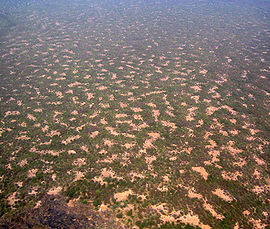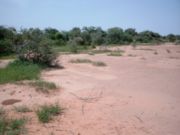
Tiger bush
Encyclopedia


Patterned vegetation
Patterned vegetation is a vegetation community that exhibits distinctive and repetitive patterns. Examples of patterned vegetation include fir waves, tiger bush, and string bog. The patterns typically arise from an interplay of phenomena that differentially encourage plant growth or mortality...
community
Community
The term community has two distinct meanings:*a group of interacting people, possibly living in close proximity, and often refers to a group that shares some common values, and is attributed with social cohesion within a shared geographical location, generally in social units larger than a household...
consisting of alternating bands of tree
Tree
A tree is a perennial woody plant. It is most often defined as a woody plant that has many secondary branches supported clear of the ground on a single main stem or trunk with clear apical dominance. A minimum height specification at maturity is cited by some authors, varying from 3 m to...
s or shrub
Shrub
A shrub or bush is distinguished from a tree by its multiple stems and shorter height, usually under 5–6 m tall. A large number of plants may become either shrubs or trees, depending on the growing conditions they experience...
s, separated by bare ground
Soil
Soil is a natural body consisting of layers of mineral constituents of variable thicknesses, which differ from the parent materials in their morphological, physical, chemical, and mineralogical characteristics...
or low herb cover, that run roughly parallel to contour line
Contour line
A contour line of a function of two variables is a curve along which the function has a constant value. In cartography, a contour line joins points of equal elevation above a given level, such as mean sea level...
s of equal elevation. The patterns occur on low slopes in arid
Arid
A region is said to be arid when it is characterized by a severe lack of available water, to the extent of hindering or even preventing the growth and development of plant and animal life...
and semi-arid
Semi-arid
A semi-arid climate or steppe climate describes climatic regions that receive precipitation below potential evapotranspiration, but not extremely...
regions, such as in Australia
Australia
Australia , officially the Commonwealth of Australia, is a country in the Southern Hemisphere comprising the mainland of the Australian continent, the island of Tasmania, and numerous smaller islands in the Indian and Pacific Oceans. It is the world's sixth-largest country by total area...
, Sahel
Sahel
The Sahel is the ecoclimatic and biogeographic zone of transition between the Sahara desert in the North and the Sudanian Savannas in the south.It stretches across the North African continent between the Atlantic Ocean and the Red Sea....
ian West Africa, and North America
North America
North America is a continent wholly within the Northern Hemisphere and almost wholly within the Western Hemisphere. It is also considered a northern subcontinent of the Americas...
.
Due to the natural water harvesting capacity, many species in tiger bush usually occur only under a higher rainfall regime.
How tiger bush forms
The alternating patterns arise from the interplay of hydrologicalHydrology
Hydrology is the study of the movement, distribution, and quality of water on Earth and other planets, including the hydrologic cycle, water resources and environmental watershed sustainability...
, ecological
Ecology
Ecology is the scientific study of the relations that living organisms have with respect to each other and their natural environment. Variables of interest to ecologists include the composition, distribution, amount , number, and changing states of organisms within and among ecosystems...
, and erosion
Erosion
Erosion is when materials are removed from the surface and changed into something else. It only works by hydraulic actions and transport of solids in the natural environment, and leads to the deposition of these materials elsewhere...
al phenomena. In the regions where tiger bush is present, plant
Plant
Plants are living organisms belonging to the kingdom Plantae. Precise definitions of the kingdom vary, but as the term is used here, plants include familiar organisms such as trees, flowers, herbs, bushes, grasses, vines, ferns, mosses, and green algae. The group is also called green plants or...
growth is water-limited - the shortage of rainfall prevents vegetation
Vegetation
Vegetation is a general term for the plant life of a region; it refers to the ground cover provided by plants. It is a general term, without specific reference to particular taxa, life forms, structure, spatial extent, or any other specific botanical or geographic characteristics. It is broader...
from covering the entire landscape. Instead, trees and shrubs are able to establish by either tapping soil moisture reserves laterally or by sending root
Root
In vascular plants, the root is the organ of a plant that typically lies below the surface of the soil. This is not always the case, however, since a root can also be aerial or aerating . Furthermore, a stem normally occurring below ground is not exceptional either...
s to deeper, wetter soil depths. By a combination of plant litter
Plant litter
Plant litter, leaf litter or tree litter is dead plant material, such as leaves, bark, needles, and twigs, that has fallen to the ground. Litter provides habitat for small animals, fungi, and plants, and the material may be used to construct nests. As litter decomposes, nutrients are released to...
, root macropores, and increased surface roughness, infiltration
Infiltration (hydrology)
Infiltration is the process by which water on the ground surface enters the soil. Infiltration rate in soil science is a measure of the rate at which soil is able to absorb rainfall or irrigation. It is measured in inches per hour or millimeters per hour. The rate decreases as the soil becomes...
into the soil
Soil
Soil is a natural body consisting of layers of mineral constituents of variable thicknesses, which differ from the parent materials in their morphological, physical, chemical, and mineralogical characteristics...
around the base of these plants is enhanced. Surface runoff
Surface runoff
Surface runoff is the water flow that occurs when soil is infiltrated to full capacity and excess water from rain, meltwater, or other sources flows over the land. This is a major component of the water cycle. Runoff that occurs on surfaces before reaching a channel is also called a nonpoint source...
arriving at these plants will thus likely to become run-on
Run-on
In hydrology, run-on refers both to the process whereby surface runoff infiltrates the ground as it flows, and to the portion of runoff that infiltrates. Run-on is common in arid and semi-arid areas with patchy vegetation cover and short but intense thunderstorms...
, and infiltrate into the soil.
By contrast, the areas between these larger plants contains a greater portion of bare ground and herbaceaous plants. Both bare soil, with its smoother surface and soil crust
Soil crust
A soil crust is a layer of soil whose particles cohere because of organic material including live organisms and what they produce.- External references :* by the USGS...
s, and herbaceaus plants, with fewer macropores, inhibit infiltration. This causes much of the rainfall that falls in the inter-canopy areas to flow downslope, and infiltrate beneath the larger plants. The larger plants are in effect harvesting rainfall from the ground immediately up-slope.
Although these vegetation patterns may seems very stable through time, it is worth to note that such patterning requires specific climatic conditions. For instance, a decrease in rainfall is able to trigger patterning in formerly homogeneous vegetation within few decades.
More water will infiltrate at the up-slope edge of the canopies than down-slope. This favours the establishment and growth of plants at the up-slope edge, and mortality of those down-slope. Differences in growth and mortality across the vegetation band result in the band moving gradually upslope.
Tiger bush never develops on moderate to steep slopes, because in these cases surface runoff concentrates into narrow threads or rill
Rill
A Rill can be a:*1.) natural fluvial topographic feature;*2.) functional constructed channel to carry a water supply from a water source some distance away;*3.) aesthetic garden water feature.-Natural:...
s instead of flowing over the surface as sheet flow. Sheet flow distributes water more evenly across hillslope, allowing a contiguous vegetation band to form.
The exact roles and importance of the different phenomena is still the subject of research.
Exploitation and conservation
The woody plants comprising tiger bush are used for fire wood and as a source of foliage for grazersGrazing
Grazing generally describes a type of feeding, in which a herbivore feeds on plants , and also on other multicellular autotrophs...
. The extensive loss of tiger bush around Niamey
Niamey
-Population:While Niamey's population has grown steadily since independence, the droughts of the early 1970s and 1980s, along with the economic crisis of the early 1980s, have propelled an exodus of rural inhabitants to Niger's largest city...
, Niger
Niger
Niger , officially named the Republic of Niger, is a landlocked country in Western Africa, named after the Niger River. It borders Nigeria and Benin to the south, Burkina Faso and Mali to the west, Algeria and Libya to the north and Chad to the east...
, now threatens local giraffe
Giraffe
The giraffe is an African even-toed ungulate mammal, the tallest of all extant land-living animal species, and the largest ruminant...
populations. In neighbouring Burkina Faso
Burkina Faso
Burkina Faso – also known by its short-form name Burkina – is a landlocked country in west Africa. It is surrounded by six countries: Mali to the north, Niger to the east, Benin to the southeast, Togo and Ghana to the south, and Côte d'Ivoire to the southwest.Its size is with an estimated...
, the tiger bush vegetation is also declining.

